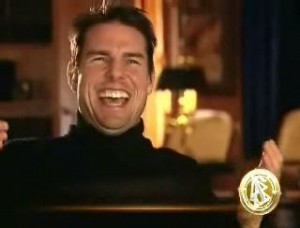Where are you taking us next, Jeff?
JEFFERSON: This week, we’re taking up Chapter 7 of the Ethics book, “The Basics of Suppression.” We’ll actually split this chapter into two articles, one on Suppressive Persons, and another, next week, on Potential Trouble Sources. Both concepts are so integral to the Scientology control system that they each deserve their own analysis. So this week, we’ll take up Suppressives.
THE BUNKER: A timely subject, considering we reported on Monday that the Church has declared Leah Remini Suppressive.
JEFFERSON: It’s axiomatic that if you want to control people, you have to give them an enemy. And if you don’t have an enemy, you have to invent one. In Hitler Speaks, former Nazi Hermann Rauschning says,
When Hitler was asked whether he thought the Jew must be destroyed, he answered: “No…we should have then to invent him. It is essential to have a tangible enemy, not merely an abstract enemy.
You can always rouse people by creating an enemy for them to hate and fear. In his book The True Believer, Eric Hoffer notes that
Mass movements can rise and spread without belief in God, but never without belief in a Devil.
THE BUNKER: So how does Hubbard present his case for the existence of the SP?
JEFFERSON: It’s interesting that the first section of this chapter, after some basic definitions, is an essay called “Two Types of People,” which is an unapologetic argument in favor of “black and white thinking.” Hubbard states that there are only two types of people, good people and bad people. He adds:
And there are no other types. Actually there aren’t even shades of gray.
In his book Overcoming Cult Mind Control, Steve Hassan says,
Even the most complex cult doctrines ultimately reduce reality into two basic poles: black versus white; good versus evil; spiritual world versus physical world; us versus them.
One of the hallmarks of a cult (or any fanatical, extremist group for that matter) is black and white thinking. Things are either black or they are white. They are good or they are evil. There are no shades of gray, no nuances. And that is what Hubbard is saying here. People are either good or bad, period. There are no shades of gray.
THE BUNKER: But hang on a second. Wasn’t he saying just the opposite a few chapters ago?
JEFFERSON: See, that’s what happens when you pay attention! Yes, exactly. When he was arguing his case for utilitarian ethics, he talked about a “gradient scale” of right and wrong. He insisted in that essay:
Terms like good and bad, alive and dead, right and wrong, are used only in conjunction with gradient scales.
When you’re making the case for utilitarian ethics, it’s important to not have black-and-white concepts of good and bad. You have to have a lot of wiggle-room. But if you’re trying to establish a villainous enemy, you’ve got to have strict black-and-white thinking. The villain you create can’t have any nuances. He can’t have shades of gray. The enemy has to be positioned as totally, irredeemably evil. Whole track evil.
THE BUNKER: So how do we identify an SP?
JEFFERSON: The next section of the chapter is entitled, tellingly, “The Anti-Social Personality, the Anti-Scientologist.” It is obvious right from the start that these things are equated in Hubbard’s mind: If you are anti-Scientology, then, by definition, you are one of the “bad people,” a Suppressive Person. Hubbard then proceeds to give his 12 attributes of an “Anti-Social Personality.” These are, briefly:
1. He or she speaks only in very broad generalities…
2. Such a person deals mainly in bad news, critical or hostile remarks…
3. The antisocial personality alters, to worsen, communication when he or she relays a message or news…
4. …an antisocial personality…does not respond to treatment or reform or psychotherapy…
5. Surrounding such a personality, we find cowed or ill associates…
6. The antisocial personality habitually selects the wrong target…
7. The antisocial cannot finish a cycle of action…
8. Many antisocial persons will freely confess to the most alarming crimes, when forced to do so, but will have no faintest sense of responsibility for them…
9. The antisocial personality supports only destructive groups and rages against and attacks any constructive or betterment group…
10. This type of personality approves only of destructive actions and fights against constructive or helpful actions or activities…
11. Helping others is an activity which drives the antisocial personality nearly berserk…
12. The antisocial personality has a bad sense of property and conceives that the idea that anyone owns anything is a pretense, made up to fool people.
THE BUNKER: So this is how Scientology decides who is labeled a Suppressive?
JEFFERSON: Organizationally, no. The list is most often used in the context of a “PTS interview,” where the Scientologist is trying to figure out if their mother or father or boss is an SP, and if they should disconnect from them. But organizationally, no. In my 37 years in Scientology, I never saw anyone declared an SP by the Church because someone analyzed their behavior against this list and found that they conformed to most or all of these attributes. I never saw that happen. Scientologists — and even some Indies — like to insist that this list is simply a useful diagnostic tool to identify people with ASPD (anti-social personality disorder), or that SP is just another name for sociopath or psychopath. Actually, if you look up the criteria for determining someone with anti-social personality disorder, the list is nothing like Hubbard’s — with the possible exception of “lack of remorse.”
If this list were really supposed to be used to find and label SPs, you would think that it’s use would be enshrined in Scientology’s “justice procedures.” You would think that an Ethics Officer would be required by policy to run the person through a checklist of these attributes before they are declared SP. In fact, it is never used that way.
THE BUNKER: So how do they actually determine if someone is an SP?
JEFFERSON: I have only seen one criterion applied, and that is if the person has criticized or attacked Scientology, Hubbard or Miscavige. If they are “anti-Scientology” then they are SP. Period. And anyone who leaves the Int Base is declared SP. Regardless of how they score on this list.
This, by the way, answers the question “How was Miscavige able to take over the Church of Scientology when Scientologists are supposed to be able to spot Suppressives?” Miscavige is a sociopath, not a Suppressive. To spot a sociopath you’d have to use the established characteristics associated with sociopathy, which are not the same as Hubbard’s list. Miscavige does not speak out against Scientology or Hubbard, therefore he’s “not an SP.”
THE BUNKER: So why issue this list of 12 attributes at all?
JEFFERSON: In my opinion, Hubbard was trying to establish a patina of scholarliness to this announcement, to position it as a “technical breakthrough.” In the mid-1960s he had a series of high-level defections and splinter groups. I think that he understood that he needed to somehow isolate and vilify those who were challenging him or speaking out against him. He needed to make sure that Scientologists would see these people as “evil” and therefore shun them and refuse to listen to them. At the same time, he didn’t want to get into a petty name-calling scuffle with these people. Positioning it as a “new technical breakthrough” and convincing Scientologists that these people had a clinical, pathological condition which made them evil — rooted, of course, in whole-track implants — was a stroke of genius. Now there was a technical reason to hate and avoid them.
THE BUNKER: In points 9, 10, and 11 above, Hubbard warns us that an SP “rages against and attacks any constructive or betterment group,” and “approves only of destructive actions and fights against constructive or helpful actions or activities.” What betterment groups do you think he is referring to here?
JEFFERSON: In fact, “betterment group” is code for “Scientology.” This becomes obvious if you try to figure out what other “betterment groups” Hubbard could possibly be referring to here. Therapists? No, couldn’t be that, since Hubbard himself raged against them. Church groups? No, couldn’t be them, since Hubbard himself often raged against Christianity. The medical profession? No, couldn’t be that as Hubbard raged against doctors. Self-help groups like EST, AA, group therapy? Nope.
The fact is, no one has ever been declared SP because they attacked the Boy Scouts or AA or any other “betterment group.” Never. They have only been declared SP because they attacked or criticized Scientology. So the true intent of points 9, 10 and 11 is pretty transparent. When Hubbard says “betterment group,” he means Scientology and only Scientology. And that is really the core of this SP “technology.”
THE BUNKER: We notice that Hubbard also notes, in point 4, that an SP “does not respond to treatment or reform or psychotherapy.” This is a really, really odd statement coming from Hubbard.
JEFFERSON: Yes, he’s been telling Scientologists for years that psychotherapy doesn’t work and doesn’t get any results. But here he is stating, in essence, “if you don’t get results from psychotherapy, that is an indicator that you may be an SP.” Again, this only becomes understandable when you realize that “treatment or reform or psychotherapy” is code for “Scientology.” He is saying “if you don’t get results from Scientology, you may be an SP.” And this is exactly how it is interpreted, as will become more and more obvious as we go through the section on PTS.
This also opens the door to what could be called the “Emperor’s New Clothes” argument: “Everyone gets results from Scientology except an SP. You didn’t get results? You must be an SP!”
THE BUNKER: There is also a list of attributes for “the social personality.”
JEFFERSON: Yes, these are the 12 attributes of an SP, reversed. And again, these may be used individually by Scientologists in the context of a PTS interview, but they are not used organizationally to clear someone of the accusation that they are an SP. Factually, if a Scientologist actually used this list to inspect the lives of, say, Leah Remini or Jason Beghe or Paul Haggis, they would have to come to the conclusion that these people could not possibly be “SP.” But this inspection does not happen.
I’ll leave you with one last bit of irony. One of the attributes of an SP that Hubbard lists is “He or she speaks only in very broad generalities.” A social personality, he tells us, “is specific in relating circumstances.” It’s interesting that the whistleblowers who are exposing Scientology’s secrets and crimes are very specific, relating specific incidents — actual time, place and event. In rebuttal, Scientology always speaks in broad generalities — “they are all lying.” “They are bitter defrocked apostates” and so on. So, according to Hubbard’s rules, who’s the SP?
——————–
Trouble in Philadephia
We heard this week from Jason Nark at Philly.com, who wondered if we remembered him. Of course we remembered his excellent portrayal of David Miscavige, which delved into the Scientology leader’s beginnings in South Philly. We’ve cited it numerous times here at the blog since Nark first published it.
He contacted us for his latest story, this one reporting on the city of Philadelphia fighting Scientology over its empty “Ideal Org” building, which has been awaiting renovations for years. Nark wanted some background on the Ideal Org program, and we sent him a lengthy reply. He was good enough to pull out a short quote for his story.
We thought we’d go ahead and publish the rest of what we sent him, since it was the first time we’ve tried to put down an overview like this of Miscavige’s obsession…
The Ideal Org program is a mess because it was always just a PR scheme.
It began in 2003, right when Tom Cruise was being brought back into the fold by Marty Rathbun on orders from Miscavige.
Cruise had been out of the church for years (but that fact was successfully hidden until only a couple of years ago), and recovering him was a major church project.
At some point, Mike Rinder tells me, Cruise complained about one of the “orgs,” saying that it was too shabby to take one of his celebrity friends. Rinder says that at the time, 2002/2003, there were three orgs that needed replacing anyway.
In Buffalo, they were losing an org to eminent domain, but had sued and won a large amount of money to purchase a new one. In Tampa, the org was in a strip mall and was in bad shape. And in Joburg, the org was in such a bad neighborhood, a church member had actually been killed in a random act of violence.
So those three became the first wave of what Miscavige began to call “Ideal” orgs. Not only did that entail finding lavish buildings (the more historic, the better), but also putting in a whole array of audiovisual displays for pulling in new public.
Rinder and I have talked about how this reflected that Miscavige increasingly was losing trust in Scientology’s old methods of attracting new members. Back in the day, they were pretty successful with human interaction. But now, Miscavige wanted machines to do the work — large flat screens running Scientology films on a loop in a museum-like setting.
Since those three original Ideal Orgs opened in 2003, Miscavige has been on a huge push to get them opened in other cities around the world. For the most part, the method has been the same.
Even if there’s an adequate org already in existence, the locals are put under intense pressure to raise millions of dollars to purchase a historic building for a new Ideal Org. After the property is secured, there’s then another round of fundraising to raise millions more for renovations.
But this is going on at the same time that Scientology is gripped by several crises, and its membership is dwindling. So you get situations like in Chicago or Philadelphia, where the money was raised to buy a great building, but then it sits, rotting, while the funds needed for renovation are getting harder and harder to get out of exhausted church members.
There’s a new story this week out of New Zealand which is very interesting. There are only a couple of hundred Scientologists in all of New Zealand, so there’s no way that Scientology is going to be able to raise millions from them to renovate an old building. So they’ve announced that CSI (Church of Scientology International) is going to spend $16 million to renovate what is going to be their Ideal Org.
I think this is yet another huge and probably unwise gamble by Miscavige. With church members around the world exhausted by fundraising, why would they want to give thousands for a local Ideal Org when CSI is just paying to open one in New Zealand? And why spend so much money in a place with almost no Scientologists? It’s bizarre.
Anyway, there’s no evidence at all that the Ideal Orgs are bringing in any new public to stare at the fancy displays. In fact, we get lots of reports that they are virtually empty.
So why has Miscavige pressed so hard to open so many of them? Again, it’s just PR. Every single time Karin Pouw puts out a statement, she will always point out that Scientology has opened new churches in 37 cities around the world (or whatever), and some naive news organizations cite that as proof that Scientology is expanding.
It’s not. It’s shrinking, and fast. It’s probably down to only about 25,000 people worldwide at this point. And more are leaving every day.
——————–
LINKS OF NOTE
Skip Press has a very interesting piece at The Morton Report about African-Americans in Scientology.
RadarOnline describes Tom Cruise’s lousy day in court, and the Daily Mail reports that Tom denies starting up a romance with fellow Scientologist Laura Prepon.
——————–
Posted by Tony Ortega on November 28, 2013 at 07:00
E-mail your tips and story ideas to tonyo94@gmail.com or follow us on Twitter. We post behind-the-scenes updates at our Facebook author page. Here at the Bunker we try to have a post up every morning at 7 AM Eastern (Noon GMT), and on some days we post an afternoon story at around 2 PM. After every new story we send out an alert to our e-mail list and our FB page.







